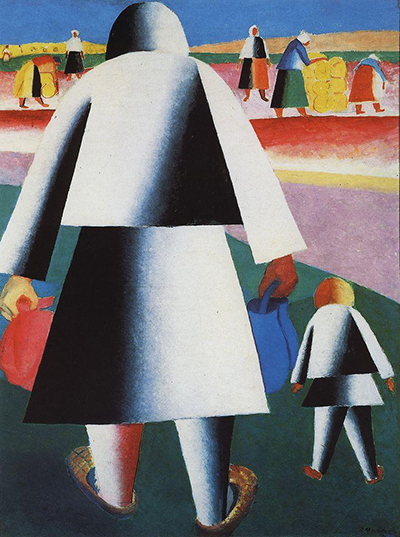Марфа и Ванька, or Marpha and Van'ka, was a modern artwork by Kazimir Malevich from around 1929. By now the artist was ageing and this would be one of his final paintings from a long and highly distinguished career.
The portrait comes from a series of work which is known as his 2nd Peasant Cycle and features a mother and child making their way through the fields of rural Russia. The figures have very bold gradients of colour which transition from white to black in a style which was typical of this artist, and may also remind some of the work of Fernand Leger. The mother here carries two bags whilst her offspring walks besides her. In the background we see a brighter palette which is used to form several other agricultural workers who are busy at work in the distance. Presumably, the woman in the foreground is off to work herself and has to take her child with her in order to make ends meet during a turbulent time in Russian history. They wear relatively modest shoes and clothing whilst wandering across a dark green path which sweeps off to the left hand side. Above them in this painting is a bright blue sky which provides a more positive outlook, and warmer colours sweep across just below, such as tones of red and orange.
Malevich would run into problems as he promoted his highly modern artistic work, particularly with some of the ruling powers who preferred more traditional, 'wholesome' methods. He would be encouraged on promoting the strength of his nation and to use realist styles, though he would never agree to that. Instead, he adapted his approach so that elements were visible from reality, but still contained elements of his modernist approach, with bright tones and reduced detail. This was enough to keep him alive and avoid any more of his work being destroyed, though without his paintings residing abroad, his legacy may well have been hidden forever. Thankfully, he left many of his more ambitious and controversial works in Germany where others could learn from them and continue his legacy even in his absence. Today he remains regarded as one of Russia's finest artists.
Peasant life in Russia was a key element in society. They were seen as contributing food to the nation, breaking their backs for the benefit of everyone else. Posters would promote their lives and underline the values of collectivisation as well as working together to strengthen the country. Malevich may not have gone along with all of these political beliefs, but he always was fond of those less fortunate and was happy enough to draw attention to their lives. Over the course of his career, Malevich would change approach several times, particularly so early on when he was fed a diet of Impressionism and Post-Impressionism before deciding that he wanted to achieve something new and so set about leaving behind an influential body of work.




